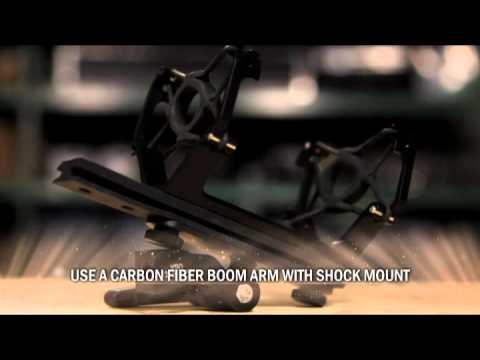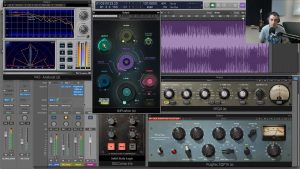Choosing Audio Gear, Equipment and Crew for Documentary Productions

Most people don’t realize that audio is the most important part of any production. Simply put, if you can’t hear the narration or interviews, no one will know what your story is all about. That’s why it’s so important to get the right gear that can make your audio sound clear.
A good audio kit doesn’t include just a microphone. That’d be too easy. Instead, in order to rent or buy a good audio package you’ll want to look at the features of a good field mixer, external capture device, headphones, and cables and adapters. Of course, you’ll also want to make sure you look for the right features in good microphones such as pickup pattern, frequency response, wireless capabilities and design. This way you’ll be able to make sure that you have the best sounding audio kit that your money can buy.
The most important part of any audio kit is the microphone. Having the right microphone for your production can be the difference between capturing crystal clear audio and noisy drivel.
The first factor to consider in a microphone is it’s pickup pattern. A pickup pattern is the shape and area where a microphone can pick up sound. There are three major types of pickup patterns used in documentary microphones. The first, omnidirectional, can pick up sound evenly from all sides of the microphone. The next type of pickup pattern is the cardioid.
This pattern resembles the shape of a heart and picks up sound mostly in front and to the sides of a microphone. This pickup pattern is the best to use for capturing the human voice. The last type of pickup pattern, hyper-cardioid or directional picks up sound mostly in front and slightly to the back of the microphone. These kinds of microphones are used most often for field shooting since they can be further away from subjects than the other pickup patterns and still capture great sound without picking up background noise at the same time.
The next important factor is frequency response. Frequency response refers to the sensitivity of the microphone to the different pitches of sound. Some microphones tend to pick up higher frequencies better, while other microphones can pick up lower frequencies well. For documentary production, you’ll want to make sure you pick up a microphone that is at least sensitive to the frequencies of the human voice which tend to be in the 80 to 7000 Hertz range.
However, a flat frequency response in which a microphone picks up all frequencies evenly is preferable.
One of the worst things about audio is having to deal with cables. They are tripping hazards, have hundreds of different connection types and limit movement. That’s where wireless audio comes in. It can eliminate the need for long cable runs from your microphone to your camera and allow you to be quick, mobile, and less intrusive. Especially for quick interviews on the street or in a studio, wireless handheld and lavalier microphones can help your talent to feel more natural. Since no one wants interference in their audio feed, make sure you spend a little extra money by buying a UHF model microphone which tends to get less interference.
The last thing to consider when buying a microphone is it’s design. Most microphones come in one of three flavors: handheld, lavalier, and shotgun.
A handheld microphone usually has a cardioid pickup pattern and is held in the hand as its name suggests. It is great for news-style interviews and are extremely easy to use but are hard to get at the correct distance from a subject and can be seen easily in a shot.
On the other hand, a lavalier is an incredibly small cardioid or omnidirectional microphone that can be clipped straight to a lapel, shirt, or tie. These microphones are great for controlled interviews, hidden wide shots, and are far from intrusive. However, they do take time to mount, are prone to clothing noise, and have parts that can be easily lost.
Lastly, a shotgun is a hyper-cardioid style microphone that can pick up audio from a distance.
These microphones allow the microphone to be out of the shot and freedom of movement for your talent. However, they will require an additional person to operate the microphone and can pick up lots of handling noise if not mounted properly. This is why most people will buy a carbon fiber telescoping boom arm with a shock mount for their shotgun microphones.
The arm allows them to get close to a subject with the microphone while the shock mount eliminates almost all handling noise. Also, many people choose to purchase a blimp and windjammer. These items can help you to further isolate wind noise from the sensitive body of the shotgun microphone. Overall, most documentarians will be best served by having at least one to two lavalier microphones for interviews and wide shots while having a shotgun style microphone for run and gun shoots or active subjects. With these two microphones at your disposal, you should be able to get every shot you need.
Another essential item to have in your audio kit is a field mixer. A field mixer is a device used to control the volume of a large number of audio inputs. The beauty of a field mixer is that it can allow you to have more than just the two audio inputs that a camera usually provides. It can also help you eliminate camera shake when correcting audio levels on the camera body as well as powering more than two microphones at a time. The best mixers will come with live compressors or limiters which prevent distortion and normalize the audio level before they reach your camera. Though they are more expensive, these kinds of mixers are almost always worth it due to the time they save in the editing room.
If you want higher quality audio capture than a camcorder can provide, capturing to an external audio device may be just the ticket. Many of these devices can record audio as uncompressed WAV files at 98 kHz and 24 bits which is much higher than the 48 kHz 8 bit audio typically offered by standard camcorders. Recording at this higher quality means that you’ll be able to put more equalization and compression on your audio in post without any major audio glitches.
Lastly, capturing great quality audio also requires that you can hear what your capturing in the field. This is why having a good over the ear or around the ear style of headphones is so important. These headphones will block the most outside sound from your audio which will help you to better hear any mistakes the audio might have.
Having great audio equipment is important. Using it, you can capture pristine audio that will allow you to get the message of your documentary clearly to your viewers.




